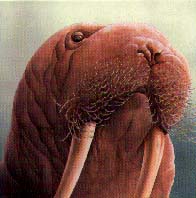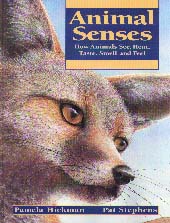|
________________
CM . . . .
Volume V Number 4 . . . . October 16, 1998
excerpt: Hold a kitchen colander up to your face and look through it. Through each hole you'll see a tiny part of what's in front of you. This is similar to how a lobster or an insect sees. You have only one lens in each of your eyes, but these creatures have many. Eyes like these are called compound eyes. Each eye is divided up into tiny sections that see little bits of the overall picture. Insects cannot focus their eyes, so they do not see images clearly. Our eyesight is about eighty times better than most insects'. Compound eyes are mainly good for seeing movement. Motion alerts the insect to danger or food.  Interesting information and activities will tickle your senses
when you open Animal Senses, the latest offering from Pamela
Hickman. A prolific author of nature books for children, she has
produced a book that makes humans better able to understand how
animal senses work.
Interesting information and activities will tickle your senses
when you open Animal Senses, the latest offering from Pamela
Hickman. A prolific author of nature books for children, she has
produced a book that makes humans better able to understand how
animal senses work.
Hickman describes each animal sense and also how humans react to the same stimuli. Human sight is keener than that of an insect, but night-foraging animals have mostly rods in their eyes, and, as a result, they can make their way about without bumping into things. (On the other hand, most nocturnal animals can't see colours.) She includes easy activities that kids can do on their own, or with the involvement of an adult, to prove the information. Her explanations are clear, without being simplistic, and, therefore, will be of use to children over a range of ages. The senses of a large number of species are explored, from the insect world to fish, snakes and mammals. The book is equipped with a useful table of contents and a detailed index. The drawings by Pat Stephens are detailed and accurate, in softer colours. The text and pictures are laid out well so that humans with binocular vision focus in on what's important. Highly recommended. Harriet Zaidman is a teacher-librarian at Niakwa Place School in Winnipeg, Manitoba.
To comment on this title or this review, send mail to cm@umanitoba.ca.
Copyright © the Manitoba Library Association.
Reproduction for personal use is permitted only if this copyright notice
is maintained. Any other reproduction is prohibited without
permission.
Published by
TABLE OF CONTENTS FOR THIS ISSUE - OCTOBER 16, 1998.
AUTHORS |
TITLES |
MEDIA REVIEWS |
PROFILES |
BACK ISSUES |
SEARCH |
CMARCHIVE |
HOME
|

